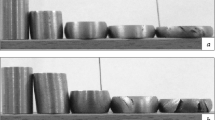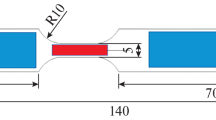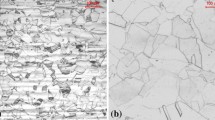Abstract
The response of alloy steels to dynamic strain aging (straining (about 2%) at relatively low temperatures) in both the quenched and tempered and ausformed conditions was investigated. Strength, ductility, and toughness were measured as a function of straining and tempering temperatures. Structural observations were made on the strained and unstrained steels. By appropriate choice of strain and tempering temperatures, the strength of both the quenched and tempered and the ausform steels was increased by about 40,000 psi. In the ausform steels, yield strengths of 270, 000 psi were achieved by dynamic strain aging with a reliability ratio (Kc/oys) of one. Since the slope of Kc/oys vs. oys is small, it is suggested that this process may be used to attain yield strengths of 300,000 psi is steels with exceptional toughness.
Résumé
La réponse d'aciers au vieillissement de défonnation (déformation (d'environ 2%) á relativement basses températures) a été étudiée pour les états trempés, revenus et ausformés. Dureté, ductilité et résistance á la rupture ont été mesurées en fonction des températures de déformation et de revenu. Des observations structurales ont été réalisées sur les aciers déformés et non déformés. Par un choic approprié des températures de déformation et de revenu, la résistance des aciers trempés, revenus et ausformés a été augmentée d' environ 40, 000 psi. Pour les aciers ausformés, des limites élastiques de 270. 000 psi ont été obtenues par vieillessement dynamique de déformation avec un rapport (Kc/σys) egal á un. Puisque la pente de Kc/σys en fonction de σys est faible, il est suggéré que ce processus peut être utilisé pour atteindre des limites élastiques de 300,000 psi pour les aciers d' exceptionelle résistance á la rupture.
Zusammenfassung
Die Reaktion legierten Stahles auf dynamische Reckalterung (ungefahr 2% Verformung bei relativ niedrigen Temperaturen) im vergüteten wie im “Ausform” — Zustand wurde untersucht. Festigkeit, Duktilität and Zähigkeit wurden als Funktionen des Verformungs-grades und der Glühtemperaturen gemessen. Die Festigkeit der vergüteten and der “ausgeformten” Stähle wurden durch eine angemessene Wahl der Verformungs — und Glüh temperaturen um ca. 40000 psi erhöht. In den “ausgeformten” Stählen wurden durch dynamische Reckalterung Streckgrenzenwerte von 270000 psi -bei einem Zuverlägssigkeitsverhältnis Kc/σys von eins erreicht. Da die Neigung der Kurve Kc/σys gegen σys, klein ist, kann angenommen werden, dass dieser Prozess benutzt warden kann, um Streckgrenzenwerte von 300000 psi und aussergewöhnliche Zähigkeit in Stählen zu erreichen.
Similar content being viewed by others
References
Special ASTM Committee Fracture Testing of High Strength Sheet Materials, ASTM Bulletin, January and February (1960)
W.W. Gerberich ASM Met. Eng. Quart, 5, 4 (1964).
V.F. Zackay, W.W. Gerberich, R. Busch, and E.R. Parker ‘The Strengt and Toughness of Dynamically Strain Aged Alloy Steels,” Proceedings of the International Conference on Fracture, Sendai, Japan (1965); to be published in 1966.
G. Thomas, D. Schmatz and W.W. Gerberich High Strength Materials, V.F. Zackay (eds), John Wiley & Sons, New York p. 251 (1965).
A.S. Keh and W.C. Leslie Structure and Properties of Engineering Materials, H.H. Stadelmaier (ed.), Interscience, New York, p.208 (1964).
Author information
Authors and Affiliations
Rights and permissions
About this article
Cite this article
Zackay, V.F., Gerberich, W.W., Busch, R. et al. The strength and toughness of dynamically strain aged alloy steel sheets. Int J Fract 2, 638–644 (1966). https://doi.org/10.1007/BF00184561
Issue Date:
DOI: https://doi.org/10.1007/BF00184561




